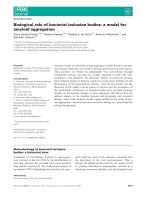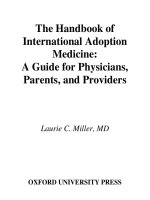Assessment of capability, knowledge and skills of vocational school graduates a basis for enhanced industry academe cooperation
Bạn đang xem bản rút gọn của tài liệu. Xem và tải ngay bản đầy đủ của tài liệu tại đây (1.45 MB, 211 trang )
ASSESSMENT OF CAPABILITY, KNOWLEDGE AND SKILLS OF
VOCATIONAL SCHOOL GRADUATES: A BASIS FOR
ENHANCED INDUSTRY-ACADEME COOPERATION
___________________________
A DISSERTATION
Presented to the Faculty of the Graduate School
Southern Luzon State University, Lucban, Quezon, Philippines
in Collaboration with
Thai Nguyen University, Socialist Republic of Vietnam
___________________________
In Partial Fulfillment
of the Requirements for the Degree
Doctor of Business Administration
___________________________
By
HA XUAN QUANG (SMITH)
December 2013
i
APPROVAL SHEET
ii
CERTIFICATE OF ORIGINALITY
This is to certify that the research work / dissertation entitled:
Assessment of Capability, Knowledge and Skills of Vocational School
Graduates: A Basis for Enhanced Industry-Academe Cooperation, orally
defended/ presented under the DBA Program jointly offered by Southern
Luzon State University of the Republic of the Philippines and Thai Nguyen
University of the Socialist Republic of Vietnam, embodies the result of original
and scholarly work carried out by the undersigned.
This dissertation does not contain words or ideas taken from published
sources or written works by other persons which have been accepted as basis
for the award of any degree from other higher education institutions, except
where proper referencing and acknowledgment were made.
Researcher/Candidate: Ha Xuan Quang (Smith)
Date Orally Defended: September 23, 2013
iii
ACKNOWLEDGMENT
In the completion of this study, the author has received significant
support and collaboration from many organizations and individuals from the
following:
Dr. Tran Duc Quy, Rector of Hanoi University of Industry; Dr. Dang
Vu Ngoan, Rector of Ho Chi Minh City University of Food Industry; Dr. Phan
Chi Chinh, Vice Rector Ho Chi Minh City University of Industry; Dr.Cung
Trong Cuong, Rector of Hue Industrial College; Dr. Duong Tu Binh, Rector
of Nam Dinh Industrial College; Mr. Nguyen Duc Sinh, Vice Rector of
Vietnam-Germany Industrial College; Mr.Ha Van Can, Rector of Industrial
Economic – Technology College, Mr. Dang Thanh Thuy, Rector of College of
Industrial Techniques; Mr. Luong Van Tien, Rector of Constructional and
Industrial College; Mr. Chu Duy Hoa, Rector of Vocational College of
Commerce, as well as Rector of Vocational College of Agricultural Mechanics
(Ministry of Agriculture and Rural Development) and Rector of Vietnam-Korea
Vocational College of Engineering (Nghe An province),
for sharing
information and cooperating in the survey;
His colleagues and students at Hanoi University of Industry, for
helping him distribute and collect questionnaires from 230 enterprises.
Without their support, the researcher could not have gathered such huge
database for research and analysis;
Leaders of Hanoi University of Industry, fellows and teachers at
Hanoi University of Industry, and Faculty of Business Administration,
iv
who have created necessary arrangements including time, budget and other
requirements to complete the DBA course and the final thesis on time;
Dr. Dang Kim Vui, President of Thai Nguyen University and Dr. Cecilia
N. Gascon, President of Southern Luzon State University, for their
cooperation in this training program which provides the researcher with an
opportunity to participate in and conduct the project;
Dr. Walberto A. Macaraan, for his exemplary guidance, monitoring
and constant encouragement throughout the course of this thesis, and;
His family, for encouraging him throughout the duration of his studies.
Ha Xuan Quang
v
DEDICATION
To my beloved wife,
two lovely daughters,
whose smiles are endless sources of energy to complete my work,
my heartfelt gratitude.
HXQ
vi
TABLE OF CONTENTS
PAGE
TITLE PAGE ………………………………………………………………..
i
APPROVAL SHEET ……………………………………………………….
ii
CERTIFICATE OF ORIGINALITY ………………………………………..
iii
ACKNOWLEDGEMENT …………………………………………………..
iv
DEDICATION ………………………………………………………………
vi
TABLE OF CONTENTS …………………………………………………..
vii
LIST OF TABLES ………………………………………………………….
ix
LIST OF FIGURES ………………………………………………………...
xi
LIST OF APPENDICES …………………………………………………...
xiii
ABSTRACT …………………………………………………………………
xiv
CHAPTER
I
II
III
INTRODUCTION ……………………………………………
1
Background of the Study …………………………………..
2
Objectives of the Study …………………………………….
4
Hypothesis of the Study ……………………………………
5
Scope and Delimitation of the Study ……………………..
6
Significance of the Study …………………………………..
8
Definition of Terms ………………………………………….
9
REVIEW OF LITERATURE ……………………………….
10
Conceptual Framework ………………………………….…
21
METHODOLOGY …………………………………………..
34
Locale of the Study …………………………………………
34
Research Design ……………………………………………
35
Population and Sample …………………………………….
36
Research Instrument ……………………………………….
38
Data Gathering Procedure …………………………………
39
Statistical Treatment ………………………........…….……
41
vii
IV
RESULTS AND DISCUSSIONS ………………………….
V
SUMMARY OF FINDINGS, CONCLUSIONS AND
42
RECOMMENDATIONS
Summary of Findings ………………………………………
77
Conclusions …………………………………………………
80
Recommendations …………………………………………
82
REFERENCES ………………………...…………………………………..
85
APPENDICES ……………………………………………………………...
88
CURRICULUM VITAE …………………………………………………….
191
viii
LIST OF TABLES
TABLE
PAGE
2.1
B.Bloom’s Taxonomy of Knowledge and Skills …………….
23
3.10
Additional Variables for Business Database ………………..
40
3.11
Additional Variables for School Database …………………..
41
4.1
Number of Schools Selected …………………………………
42
4.2
Number of Schools with the Highest Level of Training …….
42
4.3
Number of Schools Classified into Region ………………….
43
4.4
Number of Schools According to the Number of Students ..
43
4.5
Number of Enterprises Classified into Type of Ownership ..
43
4.6
Number of Enterprises Classified by Industry ………………
44
4.7
Number of Enterprises Classified by Number of Business
Years ……………………………………………………………
44
Number of Enterprises Classified by Size (Number of
Employees) ……………………………………………………..
44
Enterprises’ Assessment of Attitude and Capability to work
of Graduates from Vocational Schools ………………………
45
Enterprises’
Assessment of General Knowledge of
Graduates from Vocational Schools …………………………
47
Assessment by Enterprises of Foundation of Knowledge
and Skills of Graduates ……………………………………….
49
Assessment by Enterprises on Mechanical Knowledge and
Skills of Graduates …………………………………………….
51
Assessment by Enterprises on Electric/Electronic
Knowledge and Skills of Graduates ………………………….
53
ANOVA Accreditation for the Relationship between C1.4
and C2, C3, C4, C5 ……………………………………………
55
Respondents of Conditions Ensuring Quality of Vocational
Training Classified into Position/Title ………………………..
56
4.8
4.9
4.10
4.11
4.12
4.13
4.14
4.15
ix
TABLE
4.16
PAGE
Respondents of Conditions ensuring Quality of Vocational
Training classified into Number of Years of Working
Experience ……………………………………………………...
56
4.17
Assessment of the Vocational Training Programs …………
57
4.18
Assessment of Vocational Training Teachers ………………
58
4.19
Assessment of Facilities and Equipment for Vocational
Training …………………………………………………………
60
4.20
Program Collaboration at Vocational Training Schools ……
62
4.21
Impact of Cooperating Activities on the Knowledge and
Skill of Graduates ……………………………………………...
66
Assessment of Benefits of Cooperation by Vocational
Schools and Enterprises ………………………………………
70
4.23
Desire/Willingness to cooperate of Enterprises …………….
71
4.24
Assessment by Vocational Schools of Factors Hindering
Cooperation …………………………………………………….
74
Assessment by Enterprises of Factors hindering
Cooperation …………………………………………………….
74
4.22
4.25
x
LIST OF FIGURES
FIGURE
2.1
PAGE
Training Process and the External Factors Affecting the
Quality of Training ……………………………………………….
25
2.2
Factors Affecting the Quality of Vocational Training ………...
26
2.3
Factors Influencing Quality of Graduates (Phan Chinh Thuc,
(2003) ……………………………………………………………..
27
Impact of School-Business Cooperation in Vocational
Training Quality ………………………………………………….
29
Framework for Analysing Collaboration between Enterprises
and Vocational Training Schools ………………………………….
32
3.1
Research Design ………………………………………………..
35
3.2
Process of Research and Data Analysis ……………………...
36
4.1a
Enterprises’ assessment of attitude and capability to work of
graduates ………………………………………………………...
45
Enterprises’ Assessment of Attitude and Capability to work
of Graduates ……………………………………………………..
46
Assessment by Enterprises of the General Knowledge of
Graduates ………………………………………………………..
47
Assessment by Enterprises of Different Ownerships of the
General Knowledge of Graduates ……………………………..
48
Assessment by Enterprises of Different Industries of the
General Knowledge of Graduates ……………………………..
48
Assessment by Enterprises of Foundation of Knowledge
and Skills of Graduates …………………………………………
50
Assessment by Enterprises of Different Scales of
Foundation of Knowledge and Skills of Graduates ………….
50
Assessment by Enterprises of the Mechanical Knowledge
and Skills of Graduates …………………………………………
52
Assessment by Enterprises of Electric/Electronic Knowledge
and Skills of Graduates …………………………………………
Assessment of the Vocational Training Program …………….
53
57
2.4
2.5
4.1b
4.2a
4.2b
4.2c
4.3a
4.3b
4.4
4.5
4.6
xi
FIGURE
PAGE
4.7
Assessment of Vocational Training Teachers ………………..
59
4.8
Assessment of Facilities and Equipment for Vocational
Training …………………………………………………………...
61
4.9
Program Collaboration at Vocational Training Schools ……..
63
4.10
Impact of Cooperating Programs on Knowledge and Skills of
Graduates ………………………………………………………..
67
Assessment of Benefits of Cooperation by Schools and
Enterprises ……………………………………………………….
70
Desire/Willingness to cooperate of Enterprises ……………...
72
4.11
4.12
xii
LIST OF APPENDICES
APPENDIX
A
PAGE
Questionnaire - Research on Cooperation between
Enterprises and Vocational Schools (for leaders and
managers of enterprises) ……………………………………
89
Questionnaire - Research on Cooperation between Vocational
Schools and Enterprises in Vocational Training (for leaders,
managers and teachers of vocational schools) …………..
194
C
Cronbach Alpha ……………………………………….
100
D
Descriptive Statistics .........................................................
122
E
Statistic Tests and Regression ……………………………..
144
B
`
xiii
ABSTRACT
Title of Research
: ASSESSMENT OF CAPABILITY, KNOWLEDGE
AND SKILL OF VOCATIONAL SCHOOL
GRADUATES: A BASIS FOR ENHANCED
INDUSTRY-ACADEME COOPERATION
Researcher
: HA XUAN QUANG (SMITH)
Degree Conferred
: DOCTOR OF BUSINESS ADMINISTRATION
Name and Address
of Institution
: Southern Luzon State University Lucban, Quezon,
Philippines and Thai Nguyen University, Socialist
Republic of Vietnam
Adviser
: Dr. Walberto A. Macaraan
Year Written
: 2013
______________________________________________________________
In Vietnam, the quality of vocational training has not yet met the actual
requirements of the enterprises. One of the causes of this situation goes to
the lack of efficient and close cooperation between vocational schools and
enterprises.
With the use of interview, survey and collection of expert opinions, the
author has conducted a study on a sample of 233 enterprises for their
comments on the knowledge and skills of graduates (majoring either in
Mechanics or Electrics/ Electronics). A sample of some vocational schools
has also been a part of the research to determine the conditions which
ensures the quality of vocational training. The author has also studied some
current school-industry cooperation programs and their impact on the
knowledge and skills of vocational school graduates. On completion of the
dissertation, the author has collected and analyzed the opinions from schools
and businesses, about the benefits of cooperation, the factors hindering the
development of cooperation and the desire/willingness of the enterprises to
xiv
cooperate with schools. From the analysis of their opinions, the author has
also proposed some solutions to the development of cooperating programs in
order to improve the quality of vocational training (in terms of the knowledge
and skills of graduates). The researcher found out that the capability,
knowledge and skills of graduates from vocational schools do not meet the
requirements of the job. Businesses deliver the lowest assessment for such
skills as organizing in production, communicating, team-working and problemsolving. This situation also applies for graduates’ knowledge and skills in
statistics, English, CNC, PIC, PLC programming, electric/electronic circuit
designing and modern equipment operating. Also, the current conditions at
schools affecting capability, knowledge and skills of graduates include factors
that ensure quality of vocational training. Among these factors, the shortage of
updated training content and teachers visiting business environment as well
as the lack in quality and quantity of technology equipment are most
concerned.
In addition to this, there are three groups of cooperating program
between vocational schools and businesses, namely: information exchange,
resources supply and exchange, and vocational training plan design.
Arrangement of internship for students at businesses is the most popular and
most regular industry-academy cooperating activity. Other activities are also
done to encourage cooperation but not often. Moreover, businesses and
vocational schools share similar opinions about the benefits of cooperation in
training. Cooperation has a positive impact on knowledge and skills of
vocational students. Enterprises are willing to participate in cooperating
programs with vocational schools. Aside from these, factors hindering
xv
industry-academy cooperation in vocational training include a weak
mechanism to encourage/force the cooperation, the lack of information about
partners and the fact that one party does not assure the interests of the
partner. Finally, on the basis of the research findings, the researcher
proposed solutions to enhance industry-academy cooperation and to improve
the capability, knowledge and skills of vocational students.
xvi
1
Chapter I
INTRODUCTION
High quality human resources is one of the factors that determine the
growth of the economy. To accomplish the goal of becoming an industrialized
country by 2020, as well as to attract foreign investment, Vietnam should have
good human resources.
However, as cited in the ILO report (2013), Vietnam is in the group of
countries with the lowest labor productivity in Asia. Vietnamese productivity is
only 1/15 of Singapore, 1/11 of Japan, and 1/10 of Korea. The cause of this
problem is that science and technology level is low, and the proportion of
workers in agriculture remains high. This problem may also be caused by
poor-quality human resources and lack of skilled labor (Pham Manh Thuy,
2014). According to a survey conducted by the World Bank, over 80% of
employers said that candidates for technical positions lack skills necessary for
the job (Mori. J, 2014).
Recognizing this problem, the government of Vietnam has been issuing
a number of policies to improve the quality of human resources and promoting
the development of skills of workers. To implement the requirements of the
government, educational and training institutions conducted courses oriented
to the demand of the society (Decision No. 296 / CT-TTg dated February 27,
2010).
However, the supply of high skilled human resources has not caught
up with the demand. Graduates of vocational schools still lack knowledge,
skills and training. This is not only because TVET institutions are
2
incapacitated. Unfortunately, vocational schools can not supply high skilled
human resources without the support from businesses (Mori, J. 2014).
Improving industry - school cooperation can be an appropriate solution
to the problem of lack of knowledge, skills, capability of graduates. Some
research on industry and academe cooperation has been done but they
mainly focus on solving the problem in educational and traning institution and
do not consider TVET institutions and enterprises.
This study aimed to analyze assessment of the business on the
capacity of graduates, training conditions affecting the capability of graduates,
and analyze the actual situation of the industry – academe coperation, and
find out the factors that hinder the development of the partnership. These are
basis for offering solutions to enhance / develop industry - school partnership.
Findings of the study became the scientific basis for the policy
proposals on training and the solutions of developing vocational training of
TVET institutions to contribute to the supply of human resources with enough
knowledge, skills, capacity for Vietnam's industrialization and international
integration.
Background of the Study
“Rapid development of human resources, especially high-quality
human resources is a breakthrough of the country for 2011-2020” (Strategy of
Vietnam socio-economic development from 2011 to 2020). Human resource is
the foundation and the most important component to develop the country in a
sustainable way (Strategy of Vietnam Human Resources Development for
2011-2020).
3
Education and training is the determinant of human resources’ quality
but the quality of education is low in comparison with the requirement of the
country’s development in the new period; professional capacity of graduates
has not met job requirements (Strategy for development of education and
training for 2011-2020).
Attracting businesses to participate intently in human resources
development, building regulations, mechanisms and policies to promote
cohesion between training institution and businesses, expanding forms of
training according to the orders of the business and attracting enterprises to
participate more in human resources training, as well as institutionalizing the
responsibility of businesses in human resources development is a must
(Strategy of Vietnam Human Resources Development for 2011-2020).
The current quality of training institutions has not really met the need of
the labor market. There are many factors affecting training quality of schools.
A major cause is the relationship between schools and businesses in the area
of education that limits participation of enterprises in the training process
(MOIT, 2011).
Currently, there are 32 vocational schools under MOIT. Almost all of
them supply courses at many levels, from certificate to university degree. In
2012, with a total of 450,000 students, the number of newly-admitted students
are 210,000, graduates are 150,000 (MOIT, 2012). However, training quality
is very limited and can hardly enable trainees to handle new technology,
national development demand and enterprises. A survey of JICA in Vietnam
with the enterprises’ feedbacks/comments on the graduates from some
vocational schools under MOIT on such criteria as knowledge, technical skills,
4
attitudes at work, recognized that there are many criteria that have not fully
satisfied the expectations of enterprises (under 3 points – Using 5-point
Likert’s Scale). One of the main reasons is that vocational schools and
enterprises do not cooperate well with each other. In fact, enterprises are
seldom allowed to take part in some stages of vocational training such as
identifying the right jobs for training, designing curriculum, coordinating
internship for trainees, etc.
In this context, “Assessment of Capability, Knowledge and Skill of
Vocational School Graduates: A Basis for Enhanced Industry-Academe
Cooperation” was chosen as dissertation topic. As a vice rector of a
professional university – Hanoi University of Industry, the author has
recognized that research on the topic is realistic. The research results will not
only help the university to overcome the above problem but also provide a
basis for solutions for the improvement of vocational training quality in
Vietnam. To collect data for this study, a survey with sample of vocational
training colleges under Vietnam Ministry of Industry and Trade and another
ministry have been implemented. In addition, another survey with sample of
enterprises was also carried out in order to get their feedbacks on quality of
graduates from vocational training schools.
Objectives of the Study
This study which aimed to analyze the capacity of graduates, training
conditions affecting capability of graduates, analyze the actual situation of
industry – academe coperation, and find out the factors that hinder developing
the partnership. has the following specific objectives objectives:
5
1. To assess competency, knowledge and skills of graduates of
vocational schools with the requirements of the job.
2. To find out the factors leading to the lack / insubstantial knowledge,
skills and capacity of the graduates of vocational schools from the perspective
of conditions to ensure the quality of training in vocational schools.
3. To Identify partnership activities now being applied in vocational
schools, the level of cooperation and their effects to the knowledge and skills
of vocational students.
4.
To confirm the benefits of the cooperation program from the
perspective of both vocational schools and enterprises.
5. To explore factors hindering the development of industry-academy
cooperation.
6. To explore relationships of the assessment of conditions to ensure
training quality and school-enterprise cooperating activities.
7. To propose some solutions/recomendations to enhance industryacademy cooperation and to improve the capability, knowledge and skills of
vocational students;
Hypotheses
Based on the research issues, the following hypotheses were outlined
and tested by using statistical methods to achieve the research objectives:
H1. Enterprises are not satisfied with the working capability, knowledge
and skills of the graduates.
H2. There are differences in the assessment of capability, knowledge
and skills of graduates between different types of businesses by ownership.
6
H3. There are differences in the assessment of capability, knowledge
and skills of graduates between different types of businesses by industry.
H4. Vocational schools are not satisfied with the conditions to ensure
the quality of vocational training.
H5. Enterprises are willing to cooperate with schools in training
activities.
H6. There is no difference between enterprises and schools in the
assessment of the benefits of school-enterprise cooperation.
H7. There is a link between the assessment of conditions to ensure
training quality and school-enterprise cooperating activities.
Scope and Delimitation
Scope of the study includes vocational training schools of MOIT.
Ministry of Industry and Trade is a specialized ministry that manages most
schools in Vietnam (except MOET, MOLISA which manage education and
training, thus, they are directly in charge of some schools). The total number
of schools under direct management of MOIT is 32 and those under the
management of MOIT’s enterprises is 20. In school year 2011-2012, MOIT’s
schools admitted a total of 42,000 official vocational students, accounting for
20% of all vocational students over the country (MOIT (2012), GDVT (2012)).
The research instruments were mainly interviews and survey with
questionnaires, along with in-depth research at vocational training schools
(Hanoi University of Industry) and interviews with a number of experts in
training management of MOIT, GDVT. Ten large MOIT’s schools participate in
the survey (accounting for 60% of the total number of students and 80% of all
7
vocational students), including universities, colleges, vocational schools
located over of the country (in the North, Central and South). To compare the
results, 2 more vocational schools under the management of another ministry
and another province (Ministry of Agriculture and Rural Development and
Nghe An province) were surveyed, too.
The study focused on the development in cooperation between schools
and enterprises to improve the quality of training (knowledge and skills of
graduates). Two hundred thirty-three enterprises in partnership with MOIT’s
schools have been surveyed to assess the responsiveness to current
production requirement of graduates from vocational schools and to receive
their opinions about the cooperating program and the benefits of schoolenterprise cooperation. In terms of graduates’ quality, their knowledge and
skills (both foundation and professional one) play a part in the research. To
obtain specific evaluation results from the enterprises, the author chooses to
survey
the
knowledge
and
skills
of
graduates
in
Mechanics
and
Electrics/Electronics. There are 2 majors trained in all 12 surveyed schools as
well as other vocational schools in Vietnam (GDVT, 2012).
The actual survey data (primary) was conducted from 9/2012 to
3/2013. The secondary data was based on national statistics and reports
made by the MOIT, MOET, MOLISA, and GDVT between 2010-2012.
Due to difficulties in identifying all enterprises using graduates from
MOIT’s schools and other limitations, the sample of enterprises is mostly from
the North of Vietnam so as to facilitate the process of data collection.
Therefore, the representative of the sample was limited.
8
Significance of the Study
The significance of the research results were the following:
(1) To advance understanding of the cooperation between enterprises and
vocational training schools in order to help the colleges under MOIT to
improve the quality of graduates;
(2) To provide basis for improving cooperation with enterprises for other
vocational training schools and colleges in Vietnam;
(3) To provide reference documents for policy makers in issuing
regulations, policies, and laws related to vocational training in order to
encourage enterprises to take part in vocational training;
(4) To help enterprises understand their roles and responsibilities in
vocational training and contribute to human resources development of
Vietnam. In addition to that, the research results also show that
enterprises might get more benefits if they participate in the training
process with vocational training schools and colleges;
(5) To help students in vocational training schools and colleges recognize
the necessity of practice and internship at enterprises. The acquired
knowledge and skills at enterprises during the practice and internship
duration are of great importance to students when they join the labor
market.
(6) The research results will contribute to the rapidly developing literature
on vocational training and education, labor economics and human
resources management. By examining and comparing different models
of cooperation, the author can offer more suitable vocational training in
Vietnam and other developing countries.
9
Definition of Terms
Industry-academe
Cooperation.
All
activities
that
businesses
participate (directly or indirectly) in the training cycle of schools from
identification of training needs, design of training programs, preparation of
training, recruitment, operation of training, training assessment, improvement
in training and job assistance for students during studying and after
graduation.
Quality of Graduates. This refers to the level of knowledge, skills,
attitudes (capability) of graduates to satisfy employers.
Vocational Schools under MOIT. These include schools offering
vocational courses (universitie, colleges, vocational colleges) under the direct
management of MOIT. Schools under businesses of MOIT and schools which
are under MOIT but do not provide vocational courses are not the subjects of
this study. According to recent the statistics, there have been 32 vocational
schools under MOIT which became the subjects of this study.









